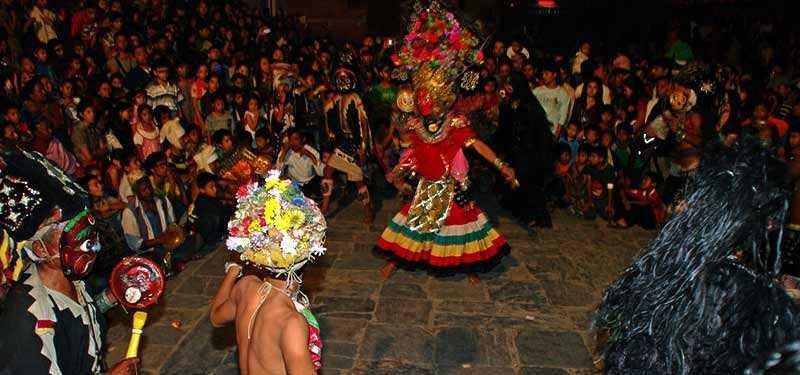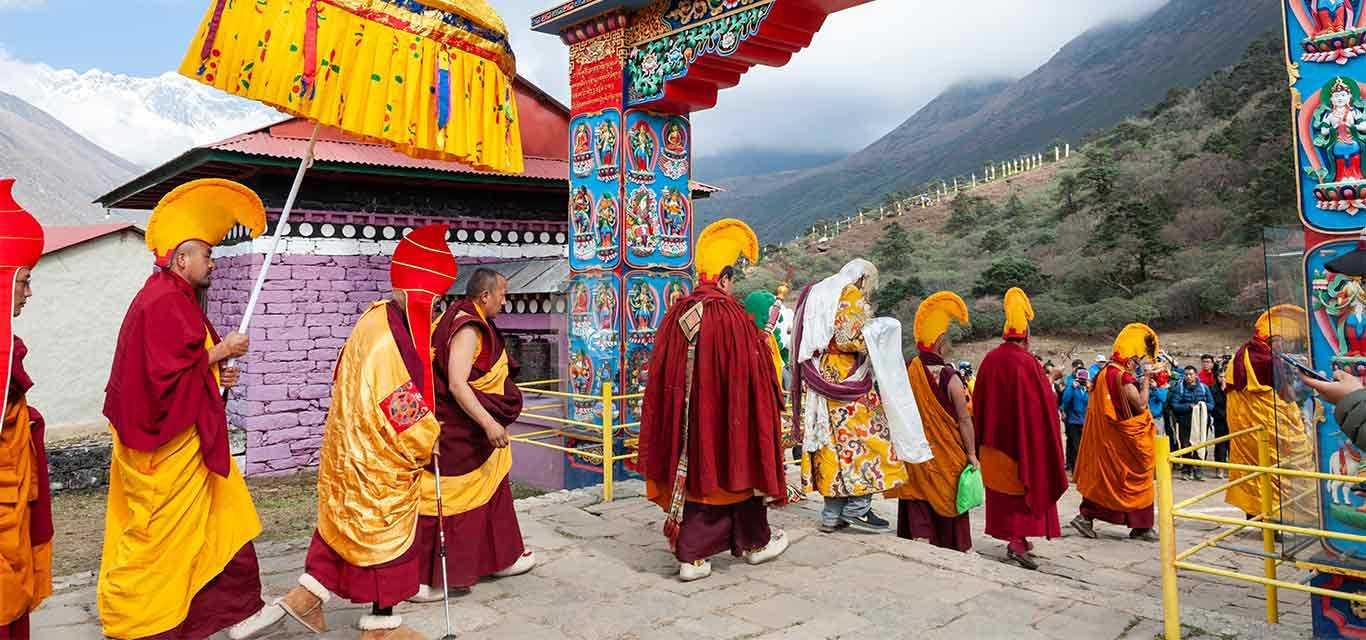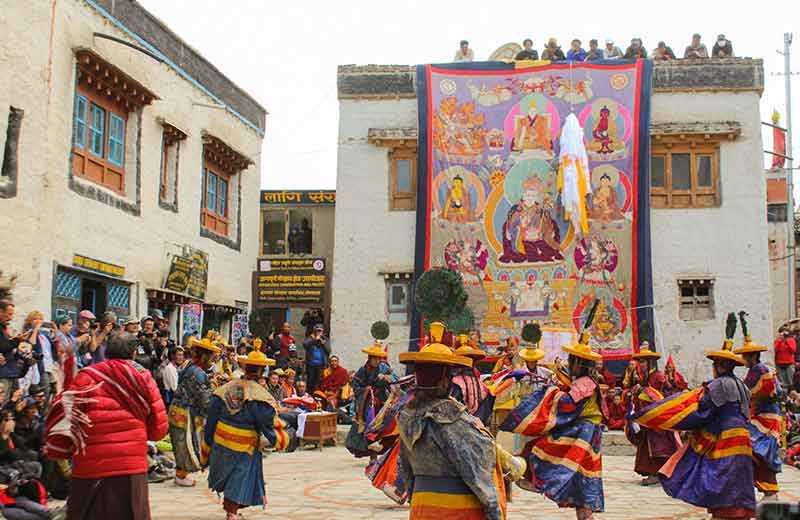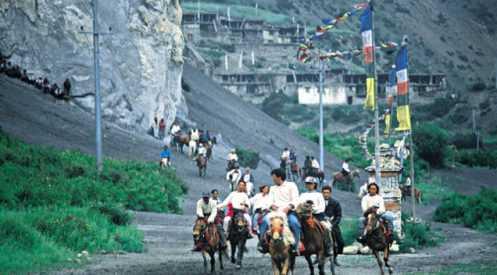Indra Jatra in Kathmandu

Indra Jatra Celebration in Kathmandu Durbar Square
The Indra Jatra, famously known as Yenya (in Nepal Bhasa), kicks off a series of joyful events for the Newar community, especially in the Kathmandu Valley. Being particularly celebrated in Kathmandu Valley, the meaning of Yenya in Nepal Bhasa translates to “Kathmandu Festival”. Indra Jatra is the most colorful and most anticipated street festival in Kathmandu, attracting people from all over the world. It also marks the start of the season of festivals, i.e., Autumn.
Famously observed, Indra Jatra, as a festival, is held for eight days in Nepal, where the city remains inactive as the people living in the area get engrossed in the colorful dances, rituals, and processions.
During this festival, there is a celebration of Lord Indra, who is considered to be the god of rain, and there is also a presentation of cultural and enthusiastic activities, culture, and festivals of Kathmandu. Starting from the primitive beginning, the festival demonstrated through the chariot processions and the mask dances of the Indra Jatra 2024 is something that anyone who wishes to know the cultural heritage of Nepal should not miss.
The Story Behind Indra Jatra
The Indra Jatra legends, of course, contain various Nepali gods and goddesses and are strictly tied to Hindu belief and the ancient history of Kathmandu. The festival is to honor the god of rain and the king of heaven, Indra, who is a paramount deity in the Hindu religion. Indra is another principal god; he is depicted as the ruler of the heavens and the god of rain, which significantly affects agriculture, and as such, is relevant to the Nepali’s everyday life depends mostly on the monsoon season for their crops.

This festival has its origins in an old story that has it that Indra, the King of the Gods, once came down to the Earth in the form of a man in search of a flower called the Parijat. There was a need to cut this celestial flower to cater to the needs of his mother, Dakini, in performing a ritual. But, at the time when Indra used to pick flowers in the Kathmandu Valley, he was caught by locals, who thought he appeared to be a thief.
Having forgotten that he was actually God and being among the humble residents of Kathmandu, Salivahana ended up being locked in a cage, and since the watery supply was interrupted, the heavens rebelled, the rains stopped, and food started to spoil.

In this respect, after Indra’s mother found out that her son had been captured alive, she voluntarily came down to the surface of the earth to ask for his release. Having known that they had detained a god, they let Indra go and, as a reward, they were bestowed with rainfall, and crops were firmly ensured. That he, after performing this act of forgiveness, did bring rain shows how the ‘divine’ and the ‘earthly’ must co-exist in harmony.
This episode is commemorated by the Indra Jatra, and it is celebrated during the dry season, particularly at the close of the rainy season when the ground has been watered, and crops are ripe for the harvest. The festival celebrates not only Lord Indra as the god of rain but also brings in concerns of people about the balance between nature and their lives.
While celebrating the festival, the streets of Kathmandu are decorated through processions, and one of these includes the reenactment of the Indra Jatra story through dances and dramas where the dancers dress up in masks and depict the story and myths behind the festival.

The celebration as such is a way of revering the rain as well as the harvest; offerings and rituals are made to Indra and his mother, Dakini. Other aspects that are observed include the celebration of the raising of the Yosin or the Linga, the pole, which is put up to symbolize the triumph of Indra, and as a symbol of a wish for more prosperity in the following year.
As one of the most colorful and rewarding cultural festivals in the heart of Nepal, Indra Jatra in Kathmandu is aimed at giving people interested in the spiritual life of Nepalese a close look at the traditions of the country. Because the legend of Indra and the annual events connected with it have been passed through generations, the cultural memory of the city has been kept, as well as people’s unity is intensified.
A Glimpse into Indra Jatra’s History
Indra Jatra began in the 10th century when King Gunakamadeva established this festival to pay homage to the god Indra and for the beginning of Kathmandu city. It was a worship festival in the earlier stage, but was changed a lot throughout the century by adding some kind of social, alert, and artistic touches that represent the cultural values of Nepal civilization. Other ethnic groups’ influences and studying as the cultural capital of the country have made the festival richer and a lively manifestation of the city.

During the Malla period, mask dances, which are referred to as the Lakhey dances and the Kumari Jatra chariot, ceased to be included in the structure of the festival. These additions converted Indra Jatra into something that was more than a pageant of devotion; it grew into a grand public carnival of the culturally significant city of Kathmandu.
Indra Jatra is today one of the most significant traditional festivals annually celebrated in Kathmandu, and it attracts both the native population and tourists, entertaining both the historical and cultural aspects of the city. It is quite a symbolic image of how this city was built and of people’s desire and passion that does not seem to fade away, being a vivid part of modern Kathmandu.
Main Events of Indra Jatra
Indra Jatra Festival, for instance, is rich in color energy, traditions, religious activities, and others that relate to the customs. Here’s a closer look at the key events that make this festival so special. Below are some of the major activities that are significant in this festival:
Opening Ceremony: Raising the Linga (Yosin)
Raising the Yosin or Linga is among the religiously significant events of the festival and is regarded as holy. The Yosin or Linga, a tall wooden pole, is placed at Hanuman Dhoka in Basantapur Durbar Square to commence the festival.

This sacred pole symbolizes Indra’s victory; it is the point where the god and human worlds merge. Some of the pre-occasion activities include the rising of the Yosin, which is later accompanied by large crowds to witness the event.
Kumari Jatra: The Living Goddess Procession
Kumari Jatra is one of the most-awaited programs of Indra Jatra, wherein the living goddess Kumari, who is considered to have the power of the gods, is taken for a chariot dance on the streets of Kathmandu.
Kumari wears a traditional Sari, donned in red and gold, as she showers blessings on thousands of devotees who wait outside the temple in the street to have a sneak peek of the goddess.

Believers drive the chariot, moving through the historical places of the city, exiting the chariot at temples and other religious sites, and offering prayers.
Pulukisi: The Elephant Dance
Pulukisi which is equally entertaining as other events. It is a dance done with a beautiful costumed dancer putting on the complexion of an elephant, signifying Airavata, the vehicle of Indra.

This spirited dance, which is done to melody and or parts of comedy, is done by replaying the events of Kathmandu’s slimy streets with many people in tow to Pulukisi or ‘leading’ him or her in what looks like a victory celebration.
The dance is akin to being comedic at the same time. It is meant to be a portrayal of the god of the earth, which is Indra.
Dhwaj: The Sacred Masks
During the festival, a colorful sacred emblem called Dhwaj remains placed in several temples and shrines across the city. These masks, which are viewed to work as shields, give a strange and sanctified facet to the festivals.
Besides the masks is folk music and drum dancing, wherein musicians and dancers on the spot dance in short set pieces to amuse the audience.
Mata Biye: Offering of Grains to Mother Earth
Mata Biye, or offering grains to Mother Earth, is not a very well-known part, but it is also a part of Indra Jatra. This ceremony is a kind of thanksgiving to the earth for the provisions that have been received, and is very important since the festival has an agricultural background. People throw grains with their bare hands as a sign of thanks for the harvest to have better harvests in the following year.
Pakuranga: A Parade of Masks
Pakuranga, that is another interesting and colorful performance, is when people demonstrate various traditional masks, each of which is associated with certain divine powers and mythological characters.
These are the masks that are performed by the professional dancers who enhance the festival by depicting the folklore of Kathmandu.
Ganesh Chariot: Devotion to the Elephant God
The Ganesh Chariot procession is observed in honor of Lord Ganesh, who is referred to as the god of wisdom and the god of `going beyond the physical barrier’.

The idol of Ganesh takes a street ride in a beautifully decorated chariot, followed by people playing musical instruments, dancing, and celebrating with the chariot.
This event shows the respect that the people of Kathmandu pay to Ganesh to make him available for blessings throughout the entire festival.
The Bhairavs: An intricate sermon, or in others, a divine show
The Bhairavs like Aakash Bhairav, Kal Bhairav, and Swet Bhairav are important ditching in Indra Jatra. Indra Chowk has a huge mask of Aakash Bhairav, while Kal Bhairav’s statue in Durbar Square is an important part of the festival.

The rice wine-drinking ceremony takes the day, though. In this event, liquor is spilled out of the mouth of the Swet Bhairav mask, and people wait for it and jump towards it to have a sip of it, as it is considered to bring luck.
Closing Ceremony: Goodbye to Gods
For the last Monday of the event, a variety of activities that mark the closing of the festival take place. The Yosin is lowered, and the deities are returned to the other world analogously.
Unlike the opening ceremony of this festival, Indra Jatra's closing ceremony is relatively less energetic, yet this portion symbolizes a moment when the spirituality of the festival is moved to a new level.
Living Tradition in Modern Kathmandu
Ironically, Indra Jatra is not only a festival. It defines a living culture of Kathmandu- the myth, history, and social structure in contemporary society.

Thus, for eight days, the city is turned into a colorful theater of the past and the present. As a result, allows both the inhabitants and the guests of the country to get to know the real Nepalese spirit.
It therefore astonishes that no matter whether the festival is made energetic by its dances, holy by the rituals, or just plain and simple by the felt spirit of Indra Jatra, it stands as a living, prominent cultural event of Kathmandu.
Indra Jatra: What to Expect
As usual, the people of Kathmandu are all set to enthrall them through Indra Jatra 2024, which is knocking at the doorstep, and to make this year’s festival even more colorful and spirited, up are being made.

The viewers can anticipate a much greater crowd of Nepalese people and tourists who come to see the magnificence of this classic festival in Kathmandu. All the customary rites and ceremonies will be held during the festival, but some other new activities will be introduced to make the festival more enjoyable to all.
First-timers or tourists who visit Nepal and attend the Indra Jatra festival must be special. It is not only an opportunity to observe countless traditions of Kathmandu’s culture but also to be a part of the thousand-year-old festival.
Tips for Tourists during Indra Jatra
Plan: Indra Jatra festival is one of the most celebrated festivals of Nepal, and the festival will start from 17th September 2024. Remember always to make your trip a prior plan. Kathmandu has crowded pedestrian traffic roads, more so during the Kumari Jatra festivals; therefore, get there as early as possible to have the best strategic positions.
Dress Modestly: As this is a religious event, there is a need to dress modestly. As for the clothes, it is better to dress in Nepali as it will be more comfortable for you, and the experience will be much more interesting.
Respect the Rituals: Bear in mind that they contain references to deep religious and anarchical beliefs. In particular, while traveling, pay attention to the local customs, especially during special occasions, for instance, Kumari Jatra or the offering of rice wine to Swet Bhairav.
Capture the Moments: The festival is a carnival-like affair with attractive colors, procession, and sophisticated, energetic moves in traditional dances. But, ensure that you ask for permission always, especially when taking close-up shots of the people, especially the Kumari.
Stay Hydrated and Safe: The event can also call for much of the participants’ physical health due to the evening and often long-standing walking around. Remember to take water so that you do not end up going around the city feeling very thirsty, and also beware of your belongings since the city is full of pickpockets.
Conclusion
Finally, Indra Jatra is more than an especially built festival; it is the spirit of ‘Kathmandu’ or more particularly the spirit of Kathmandu valley inherent in anything that invocations the spirit of the ethnic tradition.

And as you stroll along the alley paths with the sounds of folk music in your ears and sights of colorful troupes in front of your eyes, you will have to admit that this is not just a reconnaissance of history but a living culture of the Nepalese people. Thus, if you have an interest in the festivals of Kathmandu, indeed, Indra Jatra must not be missed or neglected.
Read more blogs







